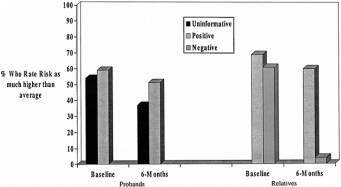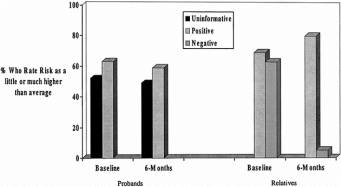|
Impact
of BRCA1/BRCA2 Mutation Testing on Psychologic
Distress in a Clinic-Based Sample
|
|
May
16, 2002 |
Abstraction Template |
|
| |
|
|
|
| Key variables & Description |
Article |
Reference
Complete the bibliographic reference for the article according to AJE format.
|
Schwartz, MD, Peshkin BN, Hughes C, et al. Impact of BRCA1/BRCA2 Mutation Testing on Psychologic Distress in a Clinic-Based Sample. J Clin Oncol 2002; 20:514-20. |
Category of HuGE information
Specify the types of information (from the list below) available in the article:
- Prevalence of gene variant
- Gene-disease association
- Gene-environment interaction
- Gene-gene interaction
- Genetic test evaluation/monitoring
|
5. Genetic test evaluation/monitoring
|
Study hypotheses or purpose
The authors study hypotheses or main purpose for conducting the study
|
Hypothesis: The objective of this study was to examine the long-term psychologic impact of receiving BRCA1/BRCA2 test results within a clinic-based testing program. |
Gene(s)
Identification of the following:
- Gene name
- Chromosome location
- Gene product/function
- Alleles
- OMIM #
|
- Gene: BRCA1
- Chromosome location: 17q21
- Gene product/function: Nuclear cell cycle regulated phosphoproteins of breast epithelium
- Alleles: Not specified
- OMIM #: 113705
- Gene name: BRCA2
- Chromosome location: 13q12-q13
- Gene product/function: Nuclear cell cycle regulated phosphoproteins of breast epithelium
- Alleles: Not specified
- OMIM #: 600185
|
Environmental factor(s)
Identification of the major environmental factors studied (infectious, chemical, physical, nutritional, and behavioral)
|
N/A |
Health outcome(s)
Identification of the major health outcome(s) studied |
The major health outcome studied was psychological distress from receiving results of BRCA1 and BRCA2 mutation testing. The authors measured perceived risk for breast and ovarian cancer with two Likert-style items. Participants who had undergone either bilateral mastectomy or oophorectomy did not complete the perceived risk items. The sample size for perceived risk was lower than for other outcomes. They measured cancer-specific distress with the Impact of Events Scale (IES). They measured general distress with the short form of the Hopkins Symptom Checklist (HSCL-25). Compared with women who received uninformative test results, those who received a positive test result had a greater number of affected first-degree relatives, were younger, and were more likely to be white. Among unaffected relatives, those with a positive test result were more likely to be employed full time. For the participants, no baseline or follow-up differences existed between positives and uninformatives on either breast cancer perceived risk or ovarian cancer perceived risk. The groups did not differ at baseline or follow-up on either cancer-specific or general distress. For the relatives, no baseline differences existed between positives and negatives on either breast cancer perceived risk or ovarian cancer perceived risk. However at follow-up, women who received positive BRCA1/BRCA2 test results exhibited significantly higher breast cancer perceived risk and ovarian cancer perceived risk. Compared with women who received a positive test result, women who received a negative result exhibited significantly decreased cancer-specific distress. Women who received positive results reported significantly higher perceived risk for breast and ovarian cancer than did women who received negative test results
|
Study design
Specification of the type of study design(s)
- Case-control
- Cohort
- Cross-sectional
- Descriptive or case series
- Clinical trial
- Population screening
|
2. Cohort
6. Population screening |
Case definition
For study designs 1, 4, and 5, define the following if available:
- Disease case definition
- Exclusion criteria
- Gender
- Race/ethnicity
- Age
- Time period
- Geographic location
- Number of participants
|
N/A
|
Control definition
For study design 1, define the following if available:
- Control selection criteria
- Matching variables
- Exclusion criteria
- Gender
- Race/ethnicity
- Age
- Time period
- Geographic location
- Number of participants
|
N/A
|
Cohort definition
For study designs 2, 3, and 6, define the following if available:
- Cohort selection criteria
- Exclusion criteria
- Gender
- Race/ethnicity
- Age
- Time period
- Geographic location
- Number of participants
|
- Cohort selection criteria: The cohort comprised 279 high-risk women. 186 were participants and 93 were their relatives without cancer who were included if the participants had a mutation. Participants had to have a personal history of breast or ovarian cancer and a family history of these cancers resulting in 10% or higher probability of harboring the BRCA1/BRCA2 mutations. If a deleterious mutation in BRCA1/2 was identified, testing was extended to at-risk relatives (usually first- or second-degree relatives). In this analysis, 93 female relatives without histories of breast or ovarian cancer were considered.
- Exclusion criteria: Not specified
- Gender: Female
- Race/ethnicity: Majority white
- Age:18 years and older
- Time period: 1995-1999
- Geographic location: not specified
- Number of participants: 278
94% (n=174) of the participants were white and 99% (n=92) of the relatives were white.
|
Assessment of environment factors
For studies that include gene-environment interactions, define the following, if available:
- Environmental factor
- Exposure assessment
- Exposure definition
- Number of participants with exposure data (% of total eligible)
|
N/A |
Genotyping
Specify the following:
- Gene
- DNA source
- Methodology
- Number of participants genotyped (% of total eligible)
|
- Gene: BRCA1
- DNA source: Blood
- Methodology: Sequencing and conformation sensitive gel electrophoresis
- Number of participants genotyped: 279
- Gene: BRCA2
- DNA source: Blood
- Methodology: Sequencing and conformation sensitive gel electrophoresis
- Number of participants genotyped: 279
Jewish participants were offered testing only for the three founder mutation common in that population (185delAG mutation in BRCA1; 5382insC mutation in BRCA1; 6174delT mutation in BRCA2).
A small number of Jewish participants without family histories of cancer participated in the study. Because a negative result in these women can be considered clinically informative, the authors excluded these women from the analyses reported here. Inclusion of these women did not alter the final results. Participants who received an uninformative result were told that, because this result did not rule out the possibility of hereditary breast cancer, they may still be at increased risk for developing breast or ovarian cancer and should therefore consider options for surveillance and possible risk reduction.
|
Results
Describe the major results under each of the following HuGE categories. Include tables when data are provided:
- Prevalence of gene variant
- Gene-disease association
- Gene-environment interaction
- Gene-gene interaction
- Genetic test evaluation/monitoring
|

Compared with participants who received uninformative test results, women who received a positive test result had a greater number of affected first-degree relatives (c2[1, n=186]=13.4; P<.001), were younger (c2[1, n=186]=4.8; P=.03), and were more likely to be white (c2[1, n=186]=5.2; P=.02). Among unaffected relatives, women with a positive test result were more likely to be employed full time (c2[1, n=93]=3.5; P= .06).

Fig 1. Impact of BRCA1/2 test result on perceived risk for breast cancer

Fig 2. Impact of BRCA1/2 test result on perceived risk for ovarian cancer
Psychological outcomes among probands: No baseline differences existed between positives and uninformatives on either breast cancer perceived risk (c2[1,n=156]=0.3; P< .61) or ovarian cancer perceived risk (c2[1,n=156]=1.5; P< .21). At follow-up, the groups did not differ on either breast cancer perceived risk (c2[1,n=156]=2.7; P=.10) or ovarian cancer perceived risk (c2[1,n=156]=1.2; P< .28). The groups did not differ at baseline on either cancer-specific distress or general distress. Six months after disclosure, the groups did not differ on change in cancer-specific distress or general distress. After bivariate analyses, test result was not associated with change in cancer-specific distress or general distress.

Fig 3. Impact of BRCA1/2 test result on cancer-specific distress.
Psychological outcomes among relatives: No baseline differences existed between positives and negatives on either breast cancer perceived risk (c2[1,n=91]=0.6; P=.45) or ovarian cancer perceived risk (c2[1,n=91]=0.3; P=.56). At follow-up, women who received positive BRCA1/BRCA2
test results exhibited significantly higher breast cancer perceived risk (c2[1,n=91]=36.3; P< .001) and ovarian cancer perceived risk (c2[1,n=91]=53.4; P< .001). Compared with women who received negative test results, women who received positive results reported significantly higher perceived risk for breast and ovarian cancer.

Fig 4. Impact of BRCA1/2 test result on general distress.
|
Conclusion
State the author's overall conclusions from the study |
BRCA1/BRCA2 mutations were found in 23% of the participants (n=43) and in 38% of the relatives (n=35). The BRCA1/BRCA2 genes have been linked to ovarian and breast cancers. With proper testing for early intervention and screening, many women may opt for prophylactic mastectomies or other changes in health-related behavior to reduce morbidity and mortality from hereditary breast cancer. Testing for BRCA1/BRCA2 together further validates predispositions for breast cancer and ovarian cancer. Women with family histories of breast or ovarian cancer should be tested for the BRCA1/BRCA2 mutations to determine their likelihood of developing these cancers.
Participants who received positive or uninformative test results did not experience increases in distress; they did not exhibit the substantial decreases in distress reported among relatives who received negative test results. The results suggest that clinic-based BRCA1/BRCA2 testing can
lead to psychological benefits for women who receive negative test results. At 6 months after the study, those participants who received positive or uninformative test results did not exhibit increased psychological distress or perceived risk.
|
Comments
Provide additional insight, including methodologic issues and/or concerns about the study |
Selection of the participants was biased, considering the study participants were sampled from the Washington D.C. area, where most of the population is African American. Also, differential drop-out rates may have biased the results of the study. The findings should be validated in more ethnically diverse populations and primary-care settings in which testing may be offered. If participants who were lost to follow-up were less distressed than those who completed follow-up were, the present study may have underestimated the distress reductions associated with the
receipt of negative and/or uninformative test results. Settings that fail to provide extensive pretest and post-test genetic counseling may not yield such favorable results. Future research should focus on why knowledge of risk status may not motivate adoption of prevention and screening
options.
|
